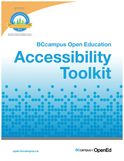 My first encounter with designing for Digital Accessibility was through a professional development program offered to my colleagues and me in the Advanced Learning Technologies Centre at College of the North Atlantic-Qatar by the Mada Assistive Technology Centre. I've been including discussions of digital accessibility in my graduate and undergraduate-level educational technology courses for several years now. I've also been "preaching" about the need to think about digital accessibility when designing eLearning courses and resources to my colleagues in various sectors. To further our ability to meet this need, in February 2017, I and my teammates in the Fraser Health Authority Online Learning Team participated in an online MOOC (Massive Open Online Course) through the University of Southampton called Digital Accessibility: Enabling Participation in the Information Society. Recently, I've received a number of requests for more information and resources -- both from my students, and my colleagues. I'm also working on a couple of new courses, where I'll be discussing this topic again. So, I figured that I would compile some of my favorites from several courses I've taught into a single blog post on the Power Learning Blog site. This post is by no means comprehensive, and I highly encourage you to search out the legislation, guidelines, and toolkits for your own province, state, or region... but these are solid resources that will help you understand the importance of addressing digital accessibility for online teaching and learning. I'll start with this excellent video by Berman (2014), who does a great job of showing us why we should care about Digital Accessibility: Web Accessibility Matters Traxler (2016). talks about accessibility and inclusion of all learners in the context of increased use of mobile technologies to mediate learning experiences.
Accessibility Toolkits for Online Teaching and LearningMany jurisdictions have already mandated technical and instructional design standards for user accessibility. The World Wide Web Consortium (W3C). provides an overview of accessibility issues and a list of standards that are increasingly drawn upon as the foundations of the accessibility policies, standards, and legislation being adopted by many organizations and jurisdictions. A common theme emerging from discussions of accessibility standards is that designing with accessibility in mind improves the learning experience for everyone – not just learners with specific accessibility issues.
Canadian Provincial Standards and Resources In Ontario, Accessibility in teaching and learning, including in online and blended learning contexts, is governed by the standards set out in the Accessibility for Ontarians with Disabilities Act. (AODA). The Council of Ontario Universities provides a number of excellent resources to help you make your online teaching and learning resources are accessible to all learners, and AODA compliant:  Other Canadian provinces are quickly catching up with the benchmarks set out by the AODA. In British Columbia, digital accessibility for online teaching and learning will be governed by the BC Accessibility 2024 .guidelines. BCampus recently published an Open Access eBook on how to make digital learning resources, such as eBooks, compliant with digital accessibility guidelines: More Resources
ReferencesAccessibility for Ontarians with Disabilities Act (2005, S.O. 2005, c. 11). Retrieved from https://www.ontario.ca/laws/statute/05a11
Berman, D. (2014, May 13). Web Accessibility Matters: Why Should We Care. [YouTube video]. Available from https://youtu.be/VIRx3RJzbZg College of the North Atlantic-Qatar (2018). [Web site]. Available from https://www.cna-qatar.com/ Coolidge, A., Doner, S., & Robertson, T. (2015). BCampus Open Education Accessibility Toolkit. [eBook]. Victoria, BC, Canada: BCampus. Available from https://opentextbc.ca/accessibilitytoolkit/ Council of Ontario Universities (2017a). Accessible Digital Documents & Websites. [Web page]. Accessible Campus. Available from http://www.accessiblecampus.ca/reference-library/accessible-digital-documents-websites/ (Links to an external site.) Council of Ontario Universities (2017b). Accessibility in E-Learning. [Web page]. Accessible Campus. Available from http://www.accessiblecampus.ca/tools-resources/educators-tool-kit/course-planning/accessibility-in-e-learning/ Described and Captioned Media Program (2018). Caption It Yourself. [Web page]. Available from https://dcmp.org/learn/213 Fraser Health (2018). [Website]. Available from https://www.fraserhealth.ca/ FutureLearn (n.d.). Digital Accessibility: Enabling Participation in the Information Society. [Massive Open Online Course]. Available from https://www.futurelearn.com/courses/digital-accessibility Interaction Design Foundation (2018). Web Fonts are Critical to the Online User Experience - Don’t Hurt Your Reader’s Eyes. [Web page]. Available from https://www.interaction-design.org/literature/article/web-fonts-are-critical-to-the-online-user-experience-don-t-hurt-your-reader-s-eyes The Paciello Group (n.d.). Colour Contrast Analyzer (CCA). [Web page]. Available from https://developer.paciellogroup.com/resources/contrastanalyser/ Mada (2017). Mada Assistive Technology Centre. [Web page]. Available from https://mada.org.qa/en/Pages/default.aspx Province of British Columbia (2014). Accessibility 2024: Making B.C. the most progressive province in Canada for people with disabilities by 2024. [PDF file]. Available from https://www2.gov.bc.ca/assets/gov/government/about-the-bc-government/accessible-bc/accessibility-2024/docs/accessibility2024_update_web.pdf Traxler, J. (2016). Inclusion in an age of mobility. Research In Learning Technology, 24. doi: http://dx.doi.org/10.3402/rlt.v24.31372 (Links to an external site.)Links to an external site. W3C (2016). Accessibility. [Web page] available from https://www.w3.org/standards/webdesign/accessibility
4 Comments
6/6/2021 04:43:59 am
This is a best video content. I like it so much. Thanks for best information.
Reply
9/20/2021 06:42:54 am
Creating online presence for online teachers is the need of the hour.The points raised here like the importance of SEO, human resources and too many competitive people in same field are vert true
Reply
Leave a Reply. |
AuthorRob Power, EdD, is an Assistant Professor of Education, an instructional developer, and educational technology, mLearning, and open, blended, and distributed learning specialist. Recent PostsCategories
All
Archives
June 2024
Older Posts from the xPat_Letters Blog
|

 RSS Feed
RSS Feed